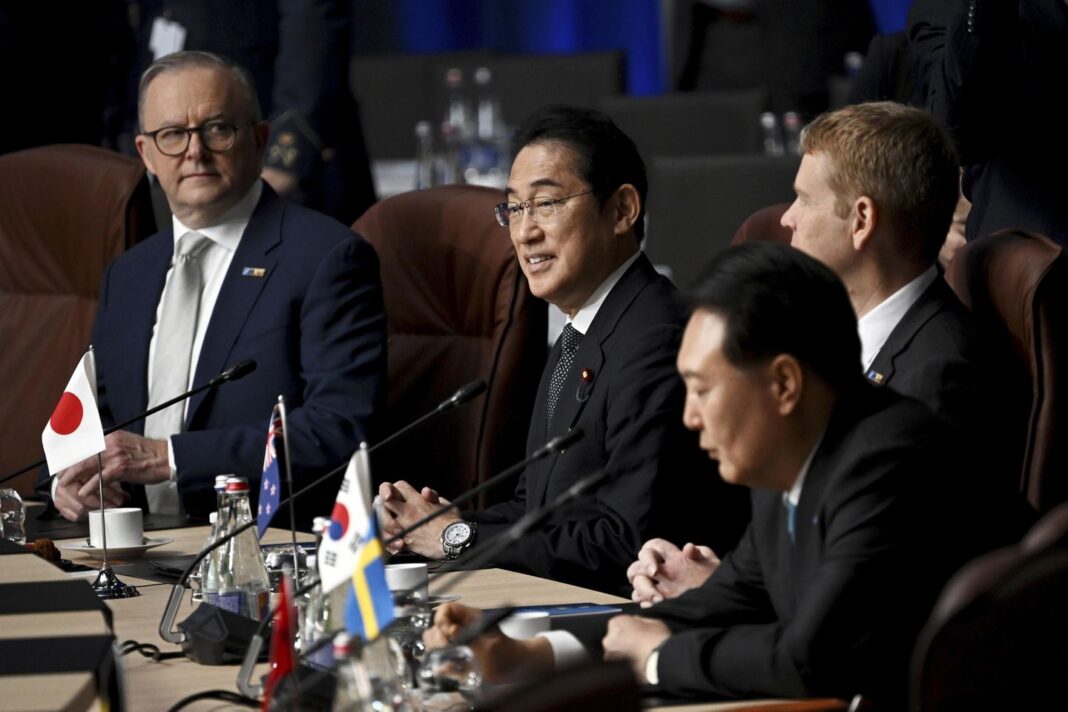The Daily Observer London Desk: Reporter- Jack Brumby
SEOUL, South Korea — Watching Asia-Pacific leaders mingle with their European counterparts at the annual NATO summit in Vilnius, Lithuania this week, U.S. strategists might well have lit up celebratory cigars.
While the media attention in Vilnius inevitably focused on the war in Ukraine, the fate of Sweden’s bid to join and other matters closer to home, the representation of major East Asian democracies at the Western military alliance gathering heralds a major shift, a sign of the rising unity of the U.S.-allied democracies on both flanks of the Eurasian landmass.
For the second straight year, leaders of the Asia-Pacific 4 (“AP4”) — Australia, New Zealand, Japan and South Korea — turned up at NATO’s annual summit. The Japanese and South Korean militaries both rank in the world’s top 10 in the latest Global Firepower’s 2023 survey.
Both the hosts and the guests stressed the importance of the links being made.
“We will continue to work with NATO, its members and partner countries to maintain and strengthen a free and open international order based on the rule of law,” said Japanese Premier Fumio Kishida. “In today’s ultra-connected era, we cannot separate the security of Europe from that of Asia,” added South Korean President Yoon Suk-yeol.
NATO leaders, in their final summit communique, wrote: “The Indo-Pacific is important for NATO, given that developments in that region can directly affect Euro-Atlantic security. … We welcome the contribution of our partners in … the region. We will further strengthen our dialogue and cooperation to tackle our shared security challenges.”
No mutual-defense treaty links NATO with Indo-Pacific powers. But as they find common ground across the vast geographies between them, the blowback is being strongly felt by Washington’s principal adversaries on the global stage — China and Russia.
Unintended consequences
In a bit of diplomatic irony, it was the warming ties between Russian President Vladimir Putin and Chinese counterpart Xi Jinping that helped accelerate the East-West coalition building against them.
“With China and Russia announcing a ‘no-limits partnership’ shortly before the invasion [of Ukraine]…the balancing coalitions at either end of Eurasia became strongly linked together,” said Joel Atkinson, an international politics professor at Seoul’s Hankuk University of Foreign Studies.
Events in Vilnius show the network of industrial democracies in North America, Europe and the Indo-Pacific that enjoy defense alliances with the United States coalescing. With the U.S.-led world order facing arguably its most serious set of economic and political challenges since the Cold War, and with developing and nonaligned nations being wooed by both sides, a reaction is underway.
“Challenges to the liberal world order are becoming more serious, so now I think the democracies are uniting or cooperating in a kind of backlash against this authoritarian agenda,” said Daniel Pinkston, an international relations professor at Troy University.
Differing degrees of enthusiasm for this “backlash” exist in various capitals. Hungary remains an outlier, while France opposes establishing a NATO office in Japan.
Yet the ties linking democracies currently look firmer than those binding authoritarian Eurasian powers. Despite their stated “no limits” partnership, China has so far declined to arm Russia, leaving Iran the sole “friend” filling Moscow’s depleted armory.
While the U.S. is the only power whose forces fully are fully deployed in both the Atlantic and Pacific, France, Germany, the Netherlands and the UK have sent assets — carrier groups, jet squadrons, ground troops — to drill with Asian partners in recent years.
While the European expeditionary forces remain far smaller than those deployed by China and the U.S., more promising avenues of cooperation have opened up in domains unconstrained by geography, such as diplomacy, technology, cyber and space.
Moreover, due to separate alliances with the U.S., eastern and western democracies increasingly use the same NATO-standard arms, munitions and components, enabling joint weapons production, arms sales and increased interoperability of equipment.
West welcomes East
The ever-closer relationship was on display in Vilnius, even if it wasn’t getting many headlines.
“No partner is closer than Japan,” NATO Secretary General Jens Stoltenberg said in a meeting with Mr. Kishida on the sidelines of the summit
Japan fields a 240,000-strong, professional military which, as constitutional constraints loosen, is increasingly deployable to hot spots around East Asia. And Tokyo has quietly built up a large and effective naval force, complete with major surface and sub-surface components, while two light aircraft carriers, armed with F-35 fighter jets, are coming online.
Japanese units are increasingly exercising with partners around the region — not just American, but also “Quad” members India and Australia, with Britain and with the strategically located Philippines. Japan’s arms industry has not supplied Ukraine, but is developing its next-generation stealth fighter in partnership with Italy and the UK.
In Vilnius, Japan and NATO signed an “Individually Tailored Partnership Program” (ITPP) to boost cooperation in 16 areas, including maritime security, emerging technologies, cyberspace, outer space and disinformation.
With 555,000 troops, South Korea fields the largest army of the AP4. However, the bulk of its forces are postured to deter North Korea on the divided and heavily armed peninsula, and its troops are overwhelmingly conscripts, reducing their availability for deployment far from home.
But Seoul’s arms industry has surged to prominence amid the Ukraine War. A major military package — conservative estimates value it at $15 billion — has been sold to Warsaw, which will also manufacture some of the equipment in an “offset” deal. The deal will bolster NATO’s eastern flank with tanks, self-propelled guns, rocket artillery and combat aircraft, while enabling Poland to send its own used equipment to Ukraine.
Moreover, while declining to supply Ukraine directly so far in the war, South Korea has “lent” the U.S. a half-million 155mm artillery shells from its stockpile, freeing up Washington to draw on its own stocks to supply Ukraine as it pursues its current offensive against Russian occupying forces.
In Vilnius, South Korea and NATO signed their own ITPP covering 11 areas, including counterterrorism, nonproliferation, emerging technologies, cyber defense and the arms industry.
Compared to Japan and South Korea, Australia and New Zealand field minimal militaries. However, both have competent forces, boast plentiful expeditionary experience, and are key to countering Chinese influence in the South Pacific. Both have also assisted Ukraine with equipment and training.
While in Europe, Australian Prime Minister Anthony Albanese signed a deal to supply Germany with light armored vehicles, and pledged more such for Ukraine. New Zealand Prime Minister Chris Hipkins agreed with NATO to cooperate on climate change, cyber defense and new technologies.
Is it sustainable?
While NATO’s communique reserved its main ire for Russia, it stated that China’s “stated ambitions and coercive policies challenge our interests, security and values.” China, the alliance said, aims to “subvert the rules-based international order, including in the space, cyber and maritime domains.”
Those lines sparked anger from Beijing, which warned NATO against “meddling in affairs beyond its borders.” China, a government spokesman said, “resolutely opposes NATO’s eastward expansion into the Asia-Pacific.”
Even so, the trend for greater cooperation and coordination between NATO and East Asian democratic partners is “growing,” reckons Mr. Atkinson.
“This will continue until the power of the Russia-China condominium peaks, or there is a split, in which case trans-Eurasian unity will decrease even as the respective coalitions in Europe and Asia, each facing their respective primary antagonist, continue to strengthen,” he said.
How far the cooperation will go is an open question.
“In global politics and international security, you will see things like AUKUS” – the deal offering Australia British and American nuclear submarine technologies, said Mr. Pinkston. “We will see these one-off, case-by-case examples.”
And the U.S. will be continually challenged to balance its interests and alliances, while dealing with European and Asian theaters where Washington does not always have a firm grasp on events.
“The U.S. will find it’s a mixed blessing: China and Russia are in the driver’s seat [and] this means the U.S. doesn’t have complete freedom to set the pace,” said Mr. Atkinson. “For example, the Biden administration is trying to tone down competition with Beijing — something the Europeans would like to see, but now you see India being worried about how far the U.S. will go.”



